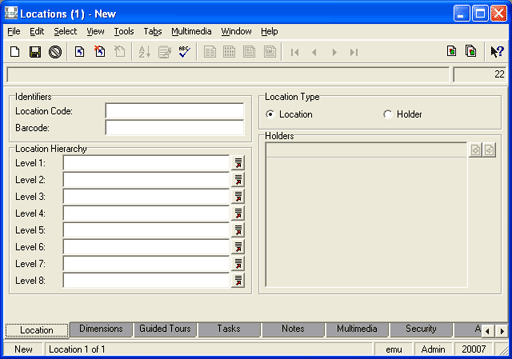The Locations module records details about display and storage locations within an institution for objects recorded in the Catalog.
When an object is attached to a Locations record and its current location is changed in EMu, an audit trail is automatically generated and displayed on the Location tab of the Catalog module.
Three fields on the Location tab of the Catalog module can attach to records in the Locations module:
|
Field |
Description |
|---|---|
|
Current Location: (Current Location) |
Records where an object is now (including on display or on loan). |
|
Permanent Location: (Other Locations) |
Records where an object is normally located when not on display or loan. |
|
Temporary Location: (Other Locations) |
Records where an object is located if its permanent location is temporarily unavailable due to repairs, replacement, etc. |
Note: The locations audit trail keeps track of an object's current location. It is therefore important that when an object is in its Permanent or Temporary location, this is also recorded in the Current Location: (Current Location) field.
Note: The time stamp of the location change that displays on the Locations tab in the Catalog module does not necessarily reflect the actual time that the object was located. This is because it is possible to manually edit a location date if the date that the location change was made in EMu was not the actual date that the relocation took place.
Note: As every institution is able to customi
| Tab | Description |
|---|---|
|
Location |
Records location details, including:
|
|
Records details for a holder location, including:
A Holder location is a location / container that can be moved, e.g. crates and solander boxes. The current location for a Holder is another (fixed) location; that is the Holder record is attached to another Locations record. Whenever the current location of the Holder is changed, the location and audit trail of all of the items in it are updated. |
|
|
Dimensions |
Holds details of physical dimensions of the location, including external and internal measurements, and X, Y, Z coordinates used for the Object Locator. |
|
Guided Tours |
|
|
Tasks |
See Tasks tab for details. |
|
Notes |
See Notes tab for details. |
|
Multimedia |
See Multimedia tab for details. |
|
Security |
See Security tab for details. |
|
Audit |
See Audit tab for details. |
|
Admin |
See Admin tab for details. |
- Add a new record in the Locations module.
- Select the Location: (Location Type) or Holder: (Location Type) radio button.
The default Location Type is Location. A Location is a fixed place - a building, floor, room, cabinet, shelf, for example. A Holder can be moved - a case, folder, crate, for example.
- Enter a location code in the Location Code: (Identifiers) field.
The Location code is generally a shorthand form of the Location Hierarchy.
- If required, enter a barcode in the Barcode: (Identifiers) field.
- Complete the Location Hierarchy fields. E.g.
Level 1 Building 1
Level 2 Level 4
Level 3 Room 10
Level 4 Cabinet 1In this case the Location Code might be
1.4.10.1 - Save the record.
Tip: EMu includes a Bulk Relocation tool to record the movement of multiple objects.
- Search the Catalog module for the object to be relocated.
- Select the Location tab.
- Delete anything in the Current Location: (Current Location) field and click Attach
 beside the field.
beside the field.The Locations module displays.
- Search for a location.
Click Attach Current Record
 in the Tool bar.
in the Tool bar.
- Search for a location.
- In the Requested by: (Current Location), Released by: (Current Location) and Accepted By: (Current Location) fields attach the record for the relevant party (if required).
- Complete the Date Moved and Time Moved fields.
Note: If these fields are left empty, they are assigned the current date and time.
- Add a note in the Movement Notes field explaining the reason for the relocation.
- Save the record.
Note: If a child object
 An object that is subordinate to another object in a hierarchy. has been made not independently moveable, it is automatically relocated together with its parent object, e.g. photographs contained in a book. If a child object has been made independently moveable, it will not be automatically relocated.
An object that is subordinate to another object in a hierarchy. has been made not independently moveable, it is automatically relocated together with its parent object, e.g. photographs contained in a book. If a child object has been made independently moveable, it will not be automatically relocated.
